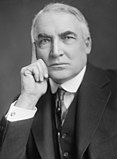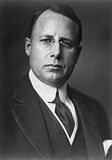| |||||||||||||||||||||||||||||||||
| |||||||||||||||||||||||||||||||||
 County Results
Harding 40-50% 50-60% 60-70% 70-80% 80-90%
| |||||||||||||||||||||||||||||||||
| |||||||||||||||||||||||||||||||||
| Elections in Minnesota |
|---|
 |
The 1920 United States presidential election in Minnesota took place on November 2, 1920, as part of the 1920 United States presidential election in which all contemporary forty-eight states participated. Voters chose 12 electors, or representatives to the Electoral College, who voted for president and vice president. This election marks the last time a candidate for president won every county in Minnesota.
The 1918 mid-term elections had seen the Midwestern farming community largely desert the Democratic Party due to supposed preferential treatment of Southern farmers:[1] Democratic seats in the Midwest fell from thirty-four to seventeen,[2] whilst Scandinavian-Americans were also vigorously opposed to entering the war.[3] Moreover, Democratic fear of Communism seen in the Palmer Raids and "Red Scare" led to Cox, then Governor of Ohio, to ban German-language instruction in public schools in 1919.[2] Much more critical for German-Americans was the view that outgoing President Woodrow Wilson was deliberately trying to punish Germany and Austria for starting the war, especially via his disregard for the United Kingdom's continuing blockade of Germany.[4] Stressing Harding's German ancestry, the German press drummed up the view that
a vote for Harding is a vote against the persecutions suffered by German-Americans during the war.[5]
As the campaign began after the Republican Party had nominated U.S. Senator Warren G. Harding of Ohio and the Democratic Party former Ohio governor James M. Cox, a further blow to the Democrats – who had never won Minnesota but came tantalizingly close in 1916 when they lost by one vote in 988[6] – occurred when the national economy suffered a major downturn following the wartime boom, resulting in plummeting agricultural prices that were especially problematic in the Midwest.[7] Whereas Cox travelled throughout the nation apart from the "Solid South" during September,[8] Harding, despite having four times the budget, campaigned from his home in Marion, Ohio. A poll by the giant Rexall drug store chain – which in 1916 had been accurate enough to predict Wilson's razor-thin wins in New Hampshire and California[9] – suggested Harding would win 382 electoral votes,[10] and at the end of October, although no more opinion polls had been published, most observers were even more convinced that the Republicans would take complete control of all branches of government.[11]
- ^ Morello, John A.; Albert D. Lasker, Advertising, and the Election of Warren G. Harding, p. 64 ISBN 0275970302
- ^ a b Hough, Jerry F.; Changing Party Coalitions: The Mystery of the Red State-Blue State Alignment, pp. 86-87 ISBN 0875864090
- ^ Saldin, Robert P., 'World War I and the System of 1896' (2010); Political Science Faculty Publications, Paper 1, pp. 825-836
- ^ Lichtman, Allan J.; Prejudice and the Old Politics: The Presidential Election of 1928, pp. 102, 115
- ^ Lubell, Samuel; The Future of American Politics, p. 135 Published 1952 by Harper and Brothers, New York
- ^ Dave Leip's Atlas of U.S. Presidential Elections; Presidential General Election Results Comparison – Minnesota
- ^ Goldberg, David Joseph; Discontented America: The United States in the 1920s, p. 47 ISBN 0801860059
- ^ Faykosh, Joseph D., Bowling Green State University; The Front Porch of the American People: James Cox and the Presidential Election of 1920 (thesis), p. 69
- ^ Pietrusza, David; 1920: The Year of the Six Presidents, p. 398 ISBN 0786721022
- ^ Bagby, Rexby; The Road to Normalcy: The Presidential Campaign and Election of 1920, pp. 158-159 ISBN 0801800455
- ^ 'Republicans Going to Win: Prospects of a Complete Victory'; The Observer, October 31, 1920, p. 13



